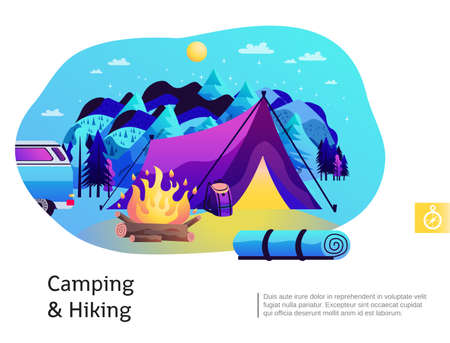1. Why Solar Chargers Are a Must-Have for Eco-Friendly Camping
When youre heading out on a camping adventure, staying connected and keeping your devices powered up is more important than ever—especially if youre using GPS, cameras, or emergency gear. But for eco-conscious campers, traditional power sources like disposable batteries or gas-powered generators dont align with sustainable outdoor living. That’s where solar chargers come in.
Sustainability Meets Adventure
Solar chargers harness the power of the sun to generate clean, renewable energy. Unlike single-use batteries that end up in landfills or fuel generators that emit harmful fumes, solar charging is a green alternative that helps reduce your environmental impact while enjoying nature.
Why Go Solar?
| Benefit | Description |
|---|---|
| Sustainable Energy | Reduces dependence on fossil fuels and minimizes waste from disposable batteries. |
| Cost-Effective | After the initial purchase, sunlight is free—no ongoing fuel or battery costs. |
| Low Maintenance | No moving parts or complex setup; just unfold and place in direct sunlight. |
| Lightweight & Portable | Modern solar chargers are designed for backpackers and campers to carry easily. |
Convenience On the Trail
No need to search for outlets or lug around heavy backup batteries. Solar chargers give you the freedom to camp off-grid for days or even weeks. Whether you’re recharging a phone, GPS unit, headlamp, or portable fan, today’s solar panels are surprisingly efficient—even in partial sunlight.
Common Devices You Can Charge with a Solar Charger:
- Smartphones and tablets
- GoPros and digital cameras
- Portable speakers
- USB rechargeable flashlights and lanterns
- Battery packs/power banks
A Better Way to Camp Responsibly
By choosing solar power, you’re not only reducing pollution but also promoting responsible camping practices. It’s an easy step toward protecting the wild places we all love to explore. With technology improving every year, solar chargers have become more reliable and affordable—making them a smart addition to any camper’s gear list in 2025.
Stay tuned as we dive into our top picks for the best solar chargers available this year—designed with eco-conscious adventurers like you in mind.
2. Key Features to Look for in a Solar Charger for Outdoor Use
When youre gearing up for your next camping trip and want to keep things eco-friendly, choosing the right solar charger can make all the difference. With so many options out there in 2025, its important to know what features really matter for outdoor use. Heres a breakdown of the key things you should look for:
Portability
Space is always limited when youre packing for a camping trip. A good solar charger should be lightweight and easy to carry. Foldable designs are great because they can tuck into a backpack without taking up too much room. Some models even come with carabiners or loops so you can hang them on your backpack while hiking.
Durability
Outdoor gear needs to stand up to rough conditions. Look for solar chargers made with rugged materials like industrial-strength plastic or reinforced fabric. Shockproof and dustproof designs are also ideal for off-grid adventures.
Charging Speed
No one wants to wait all day to charge their phone. Charging speed depends on the wattage output of the solar panel and the efficiency of its technology. Panels rated at 15W or higher tend to deliver faster results, especially under full sunlight. Also, check if the charger supports fast-charging protocols like QC 3.0 or PD (Power Delivery).
Weather Resistance
Since weather can change quickly in the outdoors, your solar charger should be able to handle it. Water-resistant or waterproof models with an IPX rating (like IPX4 or IPX7) are great choices. UV-resistant materials can also help prevent wear and tear from prolonged sun exposure.
Compatibility with Camping Gear
You’ll want a charger that works with more than just your smartphone. Many campers bring along GPS devices, headlamps, action cameras, and power banks. Make sure your solar charger has USB-A, USB-C, or even DC output ports to support multiple types of gear.
Feature Comparison Table
| Feature | Why It Matters | What to Look For |
|---|---|---|
| Portability | Makes carrying easier during hikes or travel | Lightweight, foldable design, backpack loops |
| Durability | Handles rough outdoor conditions | Shockproof, dustproof, tough materials |
| Charging Speed | Saves time when powering up devices | 15W+ output, fast-charging support (QC/PD) |
| Weather Resistance | Keeps working in rain or sun exposure | IPX rating (e.g., IPX4+), UV protection |
| Gear Compatibility | Powers multiple device types efficiently | USB-A, USB-C ports; DC outputs; adapter kits |
Pro Tip:
If you’re planning longer trips off-grid, consider pairing your solar charger with a portable power station or high-capacity power bank. That way, you can store energy during sunny hours and use it overnight or on cloudy days.

3. Our Methodology for Testing and Ranking Solar Chargers
When it comes to choosing the best solar chargers for campers who care about the environment, we know theres a lot more to it than just checking specs online. Thats why we rolled up our sleeves and got hands-on with every product on our list. Heres how we tested and ranked the top 10 solar chargers of 2025.
Real-World Field Testing
We took each solar charger out into the wild—literally. From sunny deserts in Arizona to overcast forests in the Pacific Northwest, we tested how each unit performed in different conditions that real campers face. We looked at:
- Charging Speed: How quickly the charger powered up devices under direct sunlight.
- Durability: How well it held up against dust, rain, and rough handling.
- Portability: Whether it was lightweight and easy to pack or too bulky for backpacking trips.
User Reviews and Feedback
We didnt stop with our own tests—we also dug deep into what actual users had to say. We analyzed hundreds of customer reviews from Amazon, REI, and outdoor gear forums to find patterns in user satisfaction, recurring issues, and standout features people loved.
Expert Insights
To add even more depth to our analysis, we consulted with outdoor gear experts and eco-conscious tech reviewers. They helped us understand which technical features truly matter when you’re off-grid—like power output consistency, panel efficiency, and battery compatibility.
Ranking Criteria Overview
| Criteria | Description | Weight in Final Score |
|---|---|---|
| Performance in Natural Conditions | Effectiveness in various weather and lighting environments | 30% |
| User Satisfaction | Averaged ratings and feedback from verified buyers | 25% |
| Sustainability & Eco-Friendliness | Materials used, manufacturing practices, energy efficiency | 15% |
| Portability & Design | Size, weight, ease of packing and setup | 15% |
| Value for Money | Balance between cost and features offered | 15% |
The Bottom Line on Our Process
We wanted this guide to be more than just another top-10 list. By combining hands-on testing with community input and expert advice, we aimed to highlight solar chargers that are truly worth your time—and your camping backpack space.
4. Top 10 Solar Chargers for Campers in 2025
When youre out in the wild, staying connected or simply keeping your devices powered can be a challenge — especially if you’re trying to do it sustainably. That’s where solar chargers come in. We’ve rounded up the top 10 solar chargers of 2025 that are perfect for eco-conscious campers who want reliable performance, portability, and green energy solutions. Below is a detailed comparison of each charger, including pros, cons, key features, and what makes them stand out.
Top 10 Solar Chargers Comparison Table
| Brand & Model | Wattage | Battery Capacity | Weight | Pros | Cons |
|---|---|---|---|---|---|
| Anker 625 Solar Panel | 100W | N/A (panel only) | 8.5 lbs | High efficiency, durable build, foldable design | No built-in battery storage |
| Goal Zero Nomad 50 | 50W | N/A (panel only) | 6.85 lbs | Easily pairs with Yeti batteries, rugged design | Slightly bulky for backpacking |
| Bluetti PV120 | 120W | N/A (panel only) | 12.3 lbs | Packs serious power, waterproof fabric | Larger footprint when unfolded |
| Nekteck 28W Solar Charger | 28W | N/A (panel only) | 1.2 lbs | Amazing portability, affordable price point | No battery bank included, slower charging speed |
| X-DRAGON 40W SunPower Solar Charger | 40W | N/A (panel only) | 2.6 lbs | Daisy-chain support, compact design | No weatherproof rating specified |
| BALDR Portable Power Station + Panel Bundle | 60W panel + 330Wh battery station | 330Wh (power station) | Total: ~14 lbs | Total off-grid solution, includes AC outlets and USB-C ports | Slightly heavy for hikers or solo campers |
| SOKOO 24W Waterproof Solar Charger | 24W | N/A (panel only) | .95 lbs | Splash-proof design, lightweight and compact for backpacks | No fast-charging support on all ports |
| Paxcess Rockman 200 Portable Power Station + Panel Kit | (Panel) 60W / (Station) 200Wh Battery Bank | 200Wh Battery Bank | Total: ~11.5 lbs | Total camping power kit, supports multiple device types | Takes longer to recharge via solar alone |
| BigBlue 28W Solar Charger | 28W | N/A | 1.3 lbs | Smart charging tech, great value for budget campers | No built-in storage |
| Jackery SolarSaga 100 + Explorer 300 Combo | 100W panel + 293Wh battery | 293Wh Battery | 13 lbs total | Reliable brand name, great for RVs or car camping | Not ideal for lightweight backpacking |
Main Features Breakdown by Category:
Portability:
If youre hiking into remote areas or packing light is a priority, go with something under 2 lbs like the Nekteck 28W or BigBlue 28W chargers. These fold up small and fit easily into backpacks.
Power Output:
Larger systems like the Bluetti PV120 or Jackery combos offer more wattage and capacity—ideal for powering larger devices or multi-day base camps.
Eco Benefits:
The beauty of all these models is their reliance on clean solar energy. However, those bundled with lithium iron phosphate batteries (like BALDR and Jackery) provide longer life cycles and better environmental safety than traditional lithium-ion options.
Best Overall Pick for Most Campers:
The Anker 625 offers a solid balance between efficiency and durability while remaining reasonably portable. For those needing full power stations with storage included, the BALDR bundle brings great value without compromising eco-goals.
This roundup gives you everything you need to pick a solar charger that fits your outdoor lifestyle—whether its minimalist backpacking or fully equipped overlanding.
5. Tips for Maximizing Solar Charger Efficiency on the Trail
When youre out camping and relying on solar power to keep your gear charged, every bit of sunlight counts. To get the most out of your solar charger, its not just about having a high-quality device — its also about using it right. Here are some practical tips to help you make the most of your solar charger during any outdoor adventure.
Proper Positioning Matters
The angle and placement of your solar charger can significantly impact its performance. Solar panels work best when they face direct sunlight without obstruction. Heres how to get the best positioning:
| Tip | Description |
|---|---|
| Face True South (Northern Hemisphere) | This ensures maximum exposure to sunlight throughout the day. |
| Tilt at 30-45° Angle | Aim for an angle that allows full exposure as the sun moves across the sky. |
| Avoid Shade | Even partial shade from trees or gear can drastically reduce efficiency. |
| Use Mounts or Clips | Attach panels to backpacks or tents to catch sun while on the move or stationary. |
Charge During Peak Sunlight Hours
The strongest sunlight typically occurs between 10 a.m. and 2 p.m. Try to set up your solar charger during this window for maximum output. If youre hiking during those hours, consider using a panel that mounts to your backpack so you can charge devices as you go.
Keep Panels Clean and Dry
Dirt, dust, water spots, or even fingerprints can block sunlight and reduce charging efficiency. At camp, take a few moments each day to wipe down the surface of your panels with a soft, dry cloth. Avoid harsh cleaners that could scratch or damage the surface.
Avoid Overheating Devices
If youre charging devices directly in the sun, be careful—phones and battery packs can overheat quickly. Place your device in the shade while keeping it connected to the solar panel with a longer cable if needed.
Use Power Banks for Better Energy Management
If youre unsure about consistent sunlight, charge a power bank during the day and then use it to recharge your devices at night or during cloudy weather. This gives you more flexibility and ensures you always have backup power available.
Recommended Setup for Campers
| Gear | Why It Helps |
|---|---|
| Foldable Solar Panel (20W+) | Larger surface area for faster charging; easy to pack and carry. |
| 10,000mAh+ Power Bank | Covers multiple charges for phones, headlamps, GPS devices. |
| Nylon Mounting Loops or Carabiners | Easily secure panels to backpacks or tents while optimizing sun exposure. |
A little planning goes a long way when it comes to solar charging off-grid. By keeping these simple tips in mind, youll be better prepared to stay powered up — whether youre deep in the backcountry or lounging at your favorite eco-friendly campsite.


